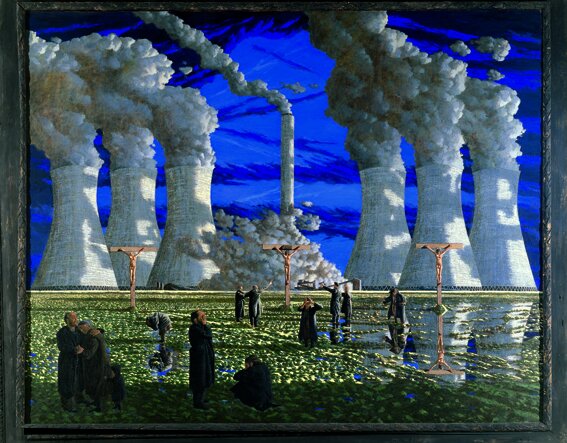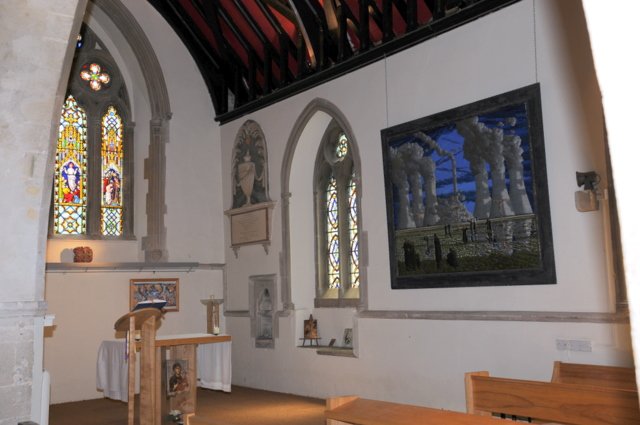Roger Wagner: Menorah


Title: Menorah
Artist: Roger Wagner (b. 1957, British)
Location: St Giles, Oxford (C of E)
Date: 1993
Wagner’s major work Menorah depicts the crucifixion in front of the Didcot power station. Menorah was acquired by the Ashmolean Museum in 2010 and hangs in St Giles Church Oxford.
‘Chagall often painted Jesus, dressed as a Jew, on the cross. But Chagall himself was Jewish. It was bold of Roger Wagner, a Christian, to take a similar theme and to juxtapose imagery of the Holocaust and the Crucifixion. The result is one of the most haunting paintings of the late 20th century. The cooling towers of Didcot power station, which dominate the Oxfordshire landscape, are both the gas ovens of Auschwitz and the Jewish seven-branched candlestick. The figures are Jewish, but not stereotypically so. They turn their backs, put their hands to their eyes and bend low with inexpressible grief. Elie Wiesel has written of the Holocaust:
“For us today –
How is one to speak of it?
How is one not to speak of it?”
Wagner’s painting captures the tension implicit in those words. Unspeakable evil – whether the gassing of Jews by complicit Christians or the killing of the Son of God by every human – leaves us in appalled silence. Yet we have to say something.
The light in Wagner’s paintings is always distinctive, almost surreal and this is certainly so here. It could be the first light of dawn or the light of evening, yet the effect is somehow starker than that. It is nothing less than the light of judgement, revealing all things with terrible searing clarity. The light on the flooded loam, shining on the clay, gives the landscape a bleak, unearthly feel. The reflection of the giant cooling towers in the water almost overwhelm. Light, because it is God’s light, uncreated and created, can never be without hope, so the light on the towers, even the light on the clouds of steam/smoke presages something better. For the presence of the Menorah indicates that even in the death camps, so many Jews sought to be faithful to the one who seemed to have abandoned them. For Christians, God is also here, in the Cross. But this hope, if it is received as such, cannot be seen apart from the light that lays everything bare, the terrible cruelty, the unspeakable grief.’ Nomination by Richard Harries, Lord Harries of Pentregarth (the former Bishop of Oxford and an A+C Adviser).
Roger Wagner (b. 1957, British) read English at Lincoln College Oxford before studying under Peter Greenham at the Royal Academy School of Art. His paintings have been shown in many solo and group exhibitions and form part of the Natwest Collection, The Ashmolean Museum, Oxford and The Fitzwilliam Museum, Cambridge. He has published several books of illustrated poems and translations. A permanent collection of his work in the Faith Museum at Auckland Castle is due to open in 2023.
Further Information
Medium: Oil on canvas
Size: 157.4 x 195.9cm
Permanent display
See Wagner’s Menorah on the Ecclesiart map here.
Other artworks in churches by Roger Wagner: Flowering Tree (stained glass), roundel, altar frontal, chasuble, altar cloth and chasuble, font cover, St Mary’s Iffley; The Dayspring, St Matthew’s Bayswater.
